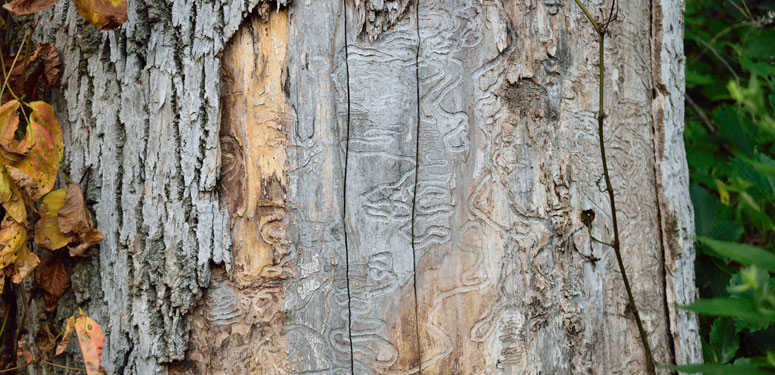Emerald Ash Borer (EAB) is a highly destructive insect that can cause significant damage to ash trees. Identifying whether an ash tree has been affected by EAB can be difficult, as the symptoms of infestation can be easily confused with those of other pests or diseases. In this blog post, we will discuss how to identify ash trees that have been affected by emerald ash borer and outline several signs to look out for.
1. Canopy dieback and thinning
One of the most common symptoms of EAB infestation in ash trees is canopy dieback and thinning. EAB larvae feed on the inner bark of the tree, disrupting the tree’s ability to transport water and nutrients throughout its branches. As a result, the tree’s canopy begins to thin and eventually dies back.
2. D-shaped exit holes
EAB larvae tunnel through the bark of ash trees and create a distinctive D-shaped exit hole when they emerge as adults. These exit holes are small, approximately 1/8 inch in diameter, and can often be found in the bark of the main trunk or branches of the tree.
3. S-shaped galleries under the bark
EAB larvae create S-shaped galleries under the bark of ash trees as they feed on the tree’s cambium layer. These galleries can be seen by carefully peeling back the bark of the tree with a knife or chisel.
4. Bark splitting
Bark splitting is another common symptom of EAB infestation in ash trees. This happens when the tree is under stress from the EAB larvae feeding on the inner bark and disrupts the flow of water and nutrients. As a result, the bark may split or crack, exposing the wood underneath.
5. Increased woodpecker activity
EAB larvae are a source of food for woodpeckers, so increased woodpecker activity on an ash tree can be a sign of infestation. Woodpeckers will often strip the bark off the tree to get at the larvae underneath, leaving distinctive patches of bare wood.
6. Bark blonding
Bark blonding occurs when woodpeckers remove the outer bark of a tree to get at the EAB larvae inside. This results in a lighter, bleached appearance on the bark that can be seen from a distance.
7. Epicomic shoot growth
Epicomic shoots are new shoots that grow from dormant buds on the trunk or branches of a tree. EAB infestation can cause stress to the tree, leading to increased epicomic shoot growth as the tree tries to compensate for the loss of leaves in the canopy.
In conclusion, identifying an EAB infestation in an ash tree can be tricky, as the symptoms can be similar to those of other pests or diseases. However, by looking for the signs listed above – including canopy dieback, exit holes, S-shaped galleries, bark splitting, woodpecker activity, bark blonding and epicomic shoot growth – you can get a better idea of whether your ash tree is affected by EAB. If you have an EAB infested tree, it is important to act fast and have it removed before it can cause damage to your property.


